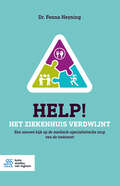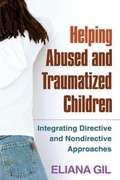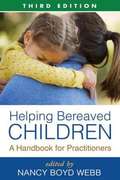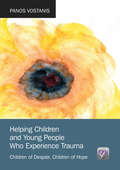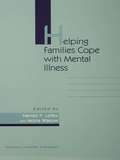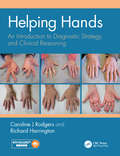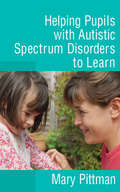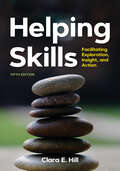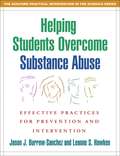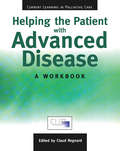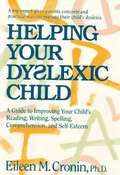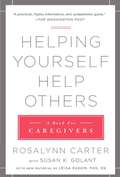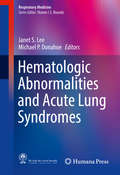- Table View
- List View
Help! Het ziekenhuis verdwijnt: Een nieuwe kijk op de medisch-specialistische zorg van de toekomst
by F.H. HeyningMoet een ziekenhuis perse een gebouw zijn? Kunnen we moderne digitale technieken niet nog veel meer inzetten voor het allerbelangrijkste: onze gezondheid? Wat als we goede en toegankelijke gezondheidszorg breder interpreteren en daar ook goede voeding en een gezonde leefomgeving bij betrekken?Vanuit haar persoonlijke ervaring als internist-hematoloog en als bestuurder in de ziekenhuiswereld beschrijft dr. Fenna Heyning hoe het ziekenhuis zich heeft ontwikkeld van een gasthuis waar langdurig patienten verpleegd worden tot een modern technisch bolwerk, tegenwoordig meestal een groot gebouw met veel glas en staal. Maar gek genoeg zijn er nog veel wachtkamers in de ziekenhuizen, moeten patienten met toch al een zwakke conditie regelmatig van ver naar het ziekenhuis reizen en worden digitale technieken nog (te) weinig gebruikt. Dat kan dat dus beter. In dit boek leest u prachtige voorbeelden van hoe het ziekenhuis van de toekomst eruit kan zien, een ziekenhuis waar zorg zoveel mogelijk thuis wordt gegeven, met goede warme menselijke zorg voor iedereen die dat nodig heeft, dankzij de inzet van creativiteit, durf en slimme techniek.
Helping Abused and Traumatized Children
by Eliana GilPresenting an integrative model for treating traumatized children, this book combines play, art, and other expressive therapies with ideas and strategies drawn from cognitive-behavioral and family therapy. Eliana Gil demonstrates how to tailor treatment to the needs of each child by using both directive and nondirective approaches. Throughout, practical clinical examples illustrate ways to target trauma-related symptomatology while also helping children process painful feelings and memories that are difficult to verbalize. The book concludes with four in-depth cases that bring to life the unique situation of each child and family, the decision making process of the therapist, and the applications of developmentally informed, creative, and flexible interventions.
Helping Bereaved Children, Third Edition
by Nancy WebbThis acclaimed work presents a range of counseling and therapy approaches for children who have experienced loss. Practitioners and students are given practical strategies for helping preschoolers through adolescents cope with different forms of bereavement, including death in the family, school, or community. Grounded in the latest research on child therapy, bereavement, trauma, and child development, the volume clearly explains the principles that guide interventions. Featuring a wealth of new content, the third edition retains the case-based format and rich descriptions of the helping process that have made the book so popular as a practitioner guide and text. New to This Edition Significantly revised and updated to reflect new information and approaches; 9 new topics covered. Covers additional types of loss war-related death in the family, deaths connected to natural disasters, and the loss of a pet. Additional therapy modalities cognitive-behavioral therapy and play therapy; conjoint caregiver child treatment; and bereavement groups and camps. Addresses how to help parents and teachers meet bereaved children's needs. Includes 11 reproducible assessment tools and handouts that can also be downloaded and printed from Guilford's website.
Helping Children and Young People Who Experience Trauma: Children of Despair, Children of Hope
by Panos VostanisThis groundbreaking new book brings together policy, evidence, practice, service development and children's narrative to provide a far-reaching overview of this vulnerable and traumatised group. It combines powerfully written, moving scenarios and draws on evidence-based research to fully illustrate concepts and present practical ideas for change t
Helping Children and Young People who Self-harm: An Introduction to Self-harming and Suicidal Behaviours for Health Professionals
by Tim McDougall Marie Armstrong Gemma TrainorEvery year thousands of children and young people attend emergency departments with problems resulting from self-harm. More still come to the attention of CAMHS teams, school nurses and other community-based services. Helping Children and Young People who Self-harm provides clear and practical guidance for health professionals and other members of the children’s workforce who are confronted by this complex and difficult area. Providing accessible evidence-based advice, this textbook looks at: what we mean by self-harm and its prevalence the legal background what works for young people who self-harm what children and young people think about self-harm assessment and interventions for self-harm prevention of self-harm service provision and care pathways. Essential for all those working with children and young people, this textbook contains a glossary of terms, practical strategies and case studies.
Helping Couples Get Past the Affair
by Donald Baucom Douglas SnyderFrom leading marital therapists and researchers, this unique book presents a three-stage therapy approach for clinicians working with couples struggling in the aftermath of infidelity. The book provides empirically grounded strategies for helping clients overcome the initial shock, understand what happened and why, think clearly about their best interests before they act, and move on emotionally, whether or not they ultimately reconcile. The volume is loaded with vivid clinical examples and carefully designed exercises for use both during sessions and at home.
Helping Families Cope With Mental Illness
by Harriet P Lefley Mona WasowIn this age of spiraling health care costs, it is imperative that the family's role in treating patients with chronic mental illness not be overlooked - by policy makers and clinicians alike. The families themselves insist that the government and care-providing agencies learn new ways to relate to them and patients. Helping Families Cope with Mental Illness is a comprehensive guide to the family's experience of chronic and serious mental illness for clinicians and educators in a wide range of mental health disciplines. It details all major areas of the clinician-family relationship - consumer perspectives, cultural diversity, social policy, ethical issues, practical coping strategies, research and training issues, major service issues, managed care, and cost-saving measures.
Helping Hands: An Introduction to Diagnostic Strategy and Clinical Reasoning, First Edition
by Richard Harrington Caroline J RodgersThis brand-new textbook introduces medical students, junior doctors, medical educators and allied health professionals to the vital skills of diagnostic strategy and clinical reasoning, both essential components of becoming an effective clinician. Taking the examination of the hands as a springboard – often the initial step in physical examination and from which a wealth of information can be gleaned – through real-life clinical cases readers are encouraged to refine their powers of observation and decision-making strategy. Key features: • Encourages a conscious approach to clinical reasoning – ‘see’ rather than just ‘look’ • Develops an understanding of why all clinicians can be responsible for diagnostic mistakes and how, with a raised awareness, they can work towards avoiding error • Outlines approaches that can be used when taking a history and when examining patients in any clinical setting • Bundled e-book for use ‘on the go’ while the companion website provides additional materials for students and lecturers including self-assessment questions and teaching guidance Outlining the process of formulating and refining an initial diagnosis, in using this book the medical student or junior doctor will develop a critical self-awareness of the strategies they employ in assessing patients, learn how to improve and enhance their skills, and feel enabled to craft an appropriate management plan.
Helping Pupils with Autistic Spectrum Disorders to Learn
by Ms Mary Pittman'The reader can gain a good overall understanding of autism and the issues which arise in teaching and learning across the spectrum but can also focus on and apply sections of the book which are specific to his or her own situation. I feel that this book is relevant to all school staff involved in educational planning for children who have autistic spectrum disorders' - REACH `The reader will be left feeling challenged to rethink the learning experience of the child with ASD in their class, more clearly attuned to the child's voice and with an armful of ideas to try out in the classroom' - TES Website Are you looking for caring and creative ways to support pupils on the Autistic Spectrum? By encouraging everyone to view the triad of impairment as a triad of opportunity, this book gives the reader guidance on how to become an autism-friendly professional. With chapters on structuring a meaningful classroom, understanding and improving behaviour, and looking at transition through the eyes of pupils on the spectrum, the book provides valuable insights gained from the author's many years of practice The book includes: - visual resources for supporting learning and behaviour - photocopiable activities for staff training excercises - practical ideas to try out in your setting - case studies to illustrate best practice - answers to frequently asked questions. This is an essential read for all teachers in mainstream and special schools, and everyone who supports pupils on the autistic spectrum.
Helping Skills for Counselors and Health Professionals: Building Culturally Competent Relationships
by Kathryn C. MacCluskie Stephanie S. Drcar Dakota King-WhiteHelping Skills for Counselors and Health Professionals provides a model of foundational helping skills that is grounded in a multicultural framework. Chapters explicitly examine implicit bias and the role of culture and systems of oppression and marginalization within the lives of both individuals and communities. The text also uses ecological systems theory to assist readers in conceptualizing the ways in which culture influences communication styles, perceptions of professional helpers, and individual needs. Readers will be introduced to concepts that increase awareness of micro and macro-level influences on helping skills, communication, and the patient’s life. Within the book’s multicultural framework, readers will also find tools for increasing self-awareness for improving the communication skills and cultural humility.
Helping Skills: Facilitating Exploration, Insight, and Action
by Clara E. HillIn this fifth edition of her best‑selling textbook, Clara Hill presents an updated model of essential helping skills for undergraduate and first‑year graduate students. Hill&’s model consists of three stages—exploration, insight, and action—in which helpers guide clients in exploring their thoughts and feelings, discovering the origins and consequences of maladaptive thoughts and behaviors, and acting on those discoveries to create positive long‑term change. This book synthesizes the author&’s extensive clinical and classroom experience into an easy‑to‑read guide to the helping process. Aspiring helping professionals will learn the theoretical principles behind the three‑stage model and fundamental clinical skills for working with diverse clients. Hill also challenges students to think critically about the helping process, their own biases, and what approach best aligns with their therapeutic skills and goals. New to this edition are: detailed guidelines for developing and revising case conceptualizations, expanded coverage of cultural awareness, updated case examples that reflect greater diversity among clients and helpers, and additional strategies for addressing therapeutic challenges.
Helping Soldiers Heal: How the US Army Created a Learning Mental Health Care System (The Culture and Politics of Health Care Work)
by Jayakanth Srinivasan Christopher IvanyHelping Soldiers Heal tells the story of the US Army's transformation from a disparate collection of poorly standardized, largely disconnected clinics into one of the nation's leading mental health care systems. It is a step-by-step guidebook for military and civilian health care systems alike. Jayakanth Srinivasan and Christopher Ivany provide a unique insider-outsider perspective as key participants in the process, sharing how they confronted the challenges firsthand and helped craft and guide the unfolding change.The Army's system was being overwhelmed with mental health problems among soldiers and their family members, impeding combat readiness. The key to the transformation was to apply the tenets of "learning" health care systems. Building a learning health care system is hard; building a learning mental health care system is even harder. As Helping Soldiers Heal recounts, the Army overcame the barriers to success, and its experience is full of lessons for any health care system seeking to transform.
Helping Students Overcome Substance Abuse: Effective Practices for Prevention and Intervention
by Leanne S. Hawken Jason J. Burrow-SanchezTwo professors at the University of Utah explore adolescent substance abuse prevalence, assessment, prevention, group interventions, individual interventions, and the referral process. Intended for school mental health professionals, the guide outlines the major substances of abuse, the steps in the screening process, research-based prevention programs, the developmental stages of therapy groups, and an action plan for community-based services. Annotation ©2007 Book News, Inc., Portland, OR (booknews.com)
Helping Teens Who Cut, Second Edition: Using DBT Skills to End Self-Injury
by Michael HollanderDiscovering that your teen &“cuts&” is every parent's nightmare. Your most urgent question is: "How can I make it stop?" Tens of thousands of worried parents have turned to this authoritative guide for information and practical guidance about the growing problem of teen self-injury. Dr. Michael Hollander is a leading expert on dialectical behavior therapy (DBT), the most effective treatment approach for cutting. Vivid stories illustrate how out-of-control emotions lead some teens to hurt themselves, how DBT can help, and what other approaches can be beneficial. You'll learn practical strategies for talking to teens about self-injury without making it worse, teaching them skills to cope with extreme emotions in a healthier way, finding the right therapist, and helping reduce stress for your whole family. Incorporating the latest research, the second edition offers a deeper understanding of the causes of self-injury and includes new DBT skills.
Helping Teens Who Cut: Understanding and Ending Self-injury
by William Pollack Michael HollanderDiscovering that your teen "cuts" is absolutely terrifying; before you understand what really motivates cutting, you may worry your child is contemplating suicide. What can you do to help when every attempt to address the behavior seems to push him or her further away? In this compassionate, straightforward book, Dr. Michael Hollander, a leading authority on self-injury, spells out the facts about cutting--and what to do to make it stop. You'll learn how overwhelming emotions lead some teens to hurt themselves, and how proven treatments--chief among them dialectical behavior therapy (DBT)--can help your child become well again. Helping Teens Who Cut demonstrates how to talk to your teen about cutting without making it worse, and explains exactly what to look for in a therapist or treatment program. Drawing on decades of clinical experience as well as the latest research, Dr. Hollander provides concrete ways to help your son or daughter cope with extreme emotions without resorting to self-injury. You'll also learn practical communication and problem-solving skills that can reduce family stress, making it easier to care for yourself and your teen during the recovery process.
Helping The Patient with Advanced Disease: A Workbook
by Claude RegnardHelping others to learn about caring for people with advanced disease has always been a fundamental part of effective palliative care. This flexible learning material, formally evaluated by the Open University, is based on the Current Learning in Palliative Care (CLIP) worksheets to cover all aspects of palliative care. Easy to use, with activities throughout, they can be reproduced as handouts when presenting to a group, or used individually alongside a tutor, or within a group setting. Each worksheet is carefully structured and assigned a learning level from introductory to advanced, to give the reader an indication of how much experience or knowledge is needed to carry out the exercise. This book provides an essential resource to arm health professionals, carers and teams with the knowledge and skills needed in their daily work.
Helping Your Child with Worry and Anxiety
by Ann CoxAre you worried about your child's mental health?Is your child or teenager showing worrying signs or symptoms?Are you waiting for a CAMHS referral, or professional treatment for your child?Helping Your Child with Worry and Anxiety is written by a team of mental health care professionals who have decades of experience working with children and young people. If your child is showing signs of anxiety or any related mental health condition, if you're thinking about consulting a professional or even on the waiting list to see one, this book will have plenty of practical strategies to support both them and you. It covers everything from spotting symptoms to managing things at home - and how/when to seek further help if you think it might be necessary. It offers advice and insight into almost every possible anxiety-related condition your child might experience, including:* Worry* Fears and phobias* Worries about eating and eating disorders* Anxiety and self-harm* Separation and social anxiety* Obsessive/compulsive behavioursThere are plenty of suggestions for how to help manage your own physical and mental health during challenging times, too. Most importantly, you can feel confident and safe as you support your child, as the advice in this book comes directly from experts with a speciality in each area, who have first-hand experience of working with children and young people in the healthcare system.
Helping Your Child with Worry and Anxiety
by Ann CoxAre you worried about your child's mental health?Is your child or teenager showing worrying signs or symptoms?Are you waiting for a CAMHS referral, or professional treatment for your child?Helping Your Child with Worry and Anxiety is written by a team of mental health care professionals who have decades of experience working with children and young people. If your child is showing signs of anxiety or any related mental health condition, if you're thinking about consulting a professional or even on the waiting list to see one, this book will have plenty of practical strategies to support both them and you. It covers everything from spotting symptoms to managing things at home - and how/when to seek further help if you think it might be necessary. It offers advice and insight into almost every possible anxiety-related condition your child might experience, including:* Worry* Fears and phobias* Worries about eating and eating disorders* Anxiety and self-harm* Separation and social anxiety* Obsessive/compulsive behavioursThere are plenty of suggestions for how to help manage your own physical and mental health during challenging times, too. Most importantly, you can feel confident and safe as you support your child, as the advice in this book comes directly from experts with a speciality in each area, who have first-hand experience of working with children and young people in the healthcare system.
Helping Your Dyslexic Child: A Guide to Improving Your Child's Reading, Writing, Spelling, Comprehension, and Self-Esteem
by Eileen CroninCronin gives parents very clear descriptions of the behaviors which generally accompany the different presentations of dyslexia. Then, she outlines straightforward steps for capitalizing on the child's abilities A sensible and informative approach to coping with this set of learning challenges..
Helping Yourself Help Others
by Susan K. Golant Rosalynn CarterThe chances are good that every one of us will become a caregiver at some point in our lives. We come to this challenge in the most personal way possible?we want to help someone we love, but we donOCOt know how, and weOCOre afraid of losing ourselves in this daunting task. If you have picked up this book, you are probably a caring person. You may prove that every day by helping someone who is elderly or developmentally disabled or who suffers from a physical or mental illness. It helps to know that Rosalynn Carter, former First Lady and a director of the Rosalynn Carter Institute for Human Development, which is committed to studying caregiving issues, knows firsthand the challenges of this labor of love. From her own personal experience as a caregiver for her father and grandfather and from that of hundreds of caregivers she has encountered before, during, and since her years in the White House, Mrs. Carter knows that caregiving can be rewarding, but also lonely, stressful, confusing, and frustrating. In "Helping Yourself Help Others," Mrs. Carter writes, ?Caregivers give so much of themselves and sometimes receive very little in return. The purpose of this book is to encourage you, to empathize with you, and to advocate for your special needs. I hope it will help you have an easier and more enjoyable life. OCO Mrs. Carter addresses the issues most caregivers face. How do you avoid burnout?the sense of feeling completely overwhelmed and unrewarded? How do you balance your responsibilities as a caregiver with the rest of your life? How can you enlist the aid of other family members? How can you educate yourself about your loved oneOCOs condition and work more effectively with the health care team? When is an institution the right choice for your loved one? How can you access helpful associations, literature and government aid? (A helpful appendix lists hundreds of resources. ) "Helping Yourself Help Others" is a rare combination of a warmly personal account of caregiving and a reassuring, clear-eyed guidebook that offers practical solutions to caregiverOCOs typical problems. Filled with empathy, this sensitive, encouraging guide will help you meet a difficult challenge head-on and find fulfillment and empowerment in your caregiving role. "
Helping Yourself Help Others: A Book for Caregivers
by Susan K. Golant Rosalynn CarterHaving cared at home for her ailing father and grandfather, Rosalynn Carter's involvement has taught her that Americans are in the middle of a caregiving crisis. In this book, Mrs. Carter addresses the social issues that have created this crisis and offers practical solutions to the problems caregivers typically experience, such as isolation, burnout, anger, and helplessness.
Helping: Resources To Improve Emotional Health And Strengthen Relationships (Childrens Safety Ser.)
by Linda Johns Lisa Fox Janine ScottNIMAC-sourced textbook
Hemangiomas and Vascular Malformations
by Raul Mattassi Dirk A. Loose Massimo VaghiSince the first edition of this book was published, much new knowledge has been gained on hemangiomas and vascular malformations. This revised and updated second edition, written by worldwide leaders in the field, fully reflects this progress. Important improvements in the treatment of hemangiomas are reviewed, including the use of beta-blockers and other medical therapies as well as advances in interventional treatments and the treatment of hemangiomas in specific locations. Vascular malformations are being investigated with increasing frequency all over the world and new challenges are emerging regarding both diagnosis and treatment. This edition considers the current role of the full range of diagnostic imaging techniques -magnetic resonance imaging, computed tomography, nuclear medicine techniques, angiography, and phlebography. The various treatment options, including laser, interventional radiological, and surgical techniques, are then presented in detail. A further individual section is devoted to the study and treatment of lymphatic malformations and dysplasias, and a series of chapters also focus on problems in the treatment of malformations in particular locations, including the thorax and viscera. This book, in atlas format, is exceptional in providing clinically relevant information on the diagnosis and treatment of both hemangiomas and vascular malformations. It will appeal to all professionals who encounter these conditions in their daily clinical practice.
Hematologic Abnormalities and Acute Lung Syndromes
by Janet S. Lee Michael P. DonahoeThis book provides a unique frame work for examining acute lung syndromes that arise from hematologic disorders or is defined by a hematologic abnormality as a key feature. Acute lung processes arising from hematologic disorders can present as life-threatening conditions, and as such, the pulmonary physician or critical care physician are often directly involved in care or called upon to provide expertise. Chapters are organized into three sections, each with an emphasis on pathogenesis and current understanding of mechanisms. The text begins with the central theme of the lungs as the direct interface between the external environment and blood, description of individual components of the hematopoietic system, their function and relevance to the lungs. The second section outlines both benign and malignant primary hematologic disorders that can lead to acute pulmonary manifestations. The final section focuses on acute lung syndromes stemming from complications of transfusion and treatment. Chapters are presented in an easy-to-access format, providing information on diagnosis, management, and outcomes. This is a valuable resource for pulmonary fellows in training, pulmonologists, critical care physicians, and physicians involved in caring for patients in the ICU.
Hematologic Cancers: From Molecular Pathobiology to Targeted Therapeutics
by Eduardo Sotomayor Jianguo TaoIn the last decade, there has been a remarkable explosion of knowledge in hematologic cancer from basic molecular biology and pathology to clinical therapy. This has led to many new advance and insights in the understanding of pathobiology of malignant hematology. New knowledge of disease molecular pathology, cytogenetic, epigenetic and genomic alterations have provided new strategies to attack and eradicate tumor cells at molecular level and significantly impacted our current therapeutics for hematological malignancies. The recent and ongoing rapid expansion of knowledge in this area has become extensive, dynamic and diffuse over the literature and research publications. This has led to the need to capture and compile the new and current information about hematologic cancer with special emphasis on translation from molecular pathobiology to targeted therapeutics. In this book experts from around the world share their thoughts and knowledge about the pathobiology of hematologic cancer, as well as their view on current treatment approaches and future development in these malignant hematologic diseases. This book is well suited for hematology residents, fellows and hematology-oncology physicians, hematopathologist as well as basic research scientist in the area of hematologic malignancies.
